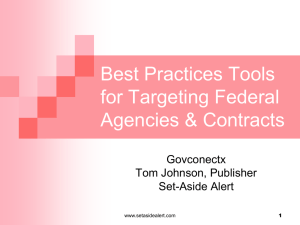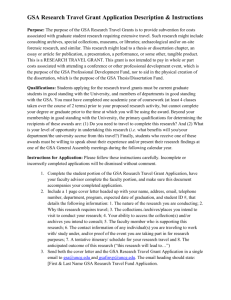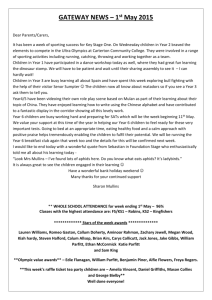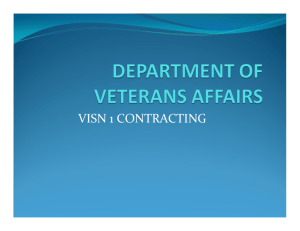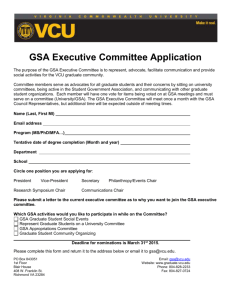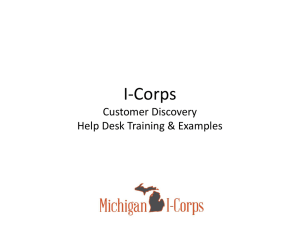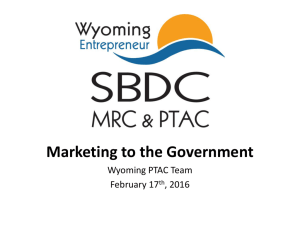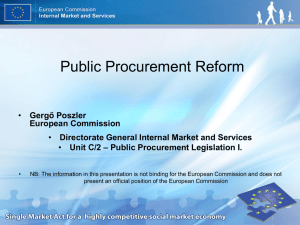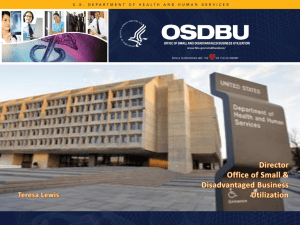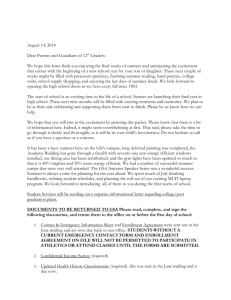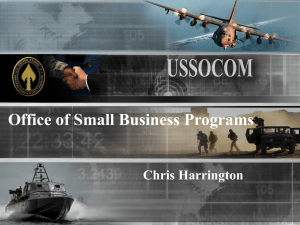United States Department of Defense(49)
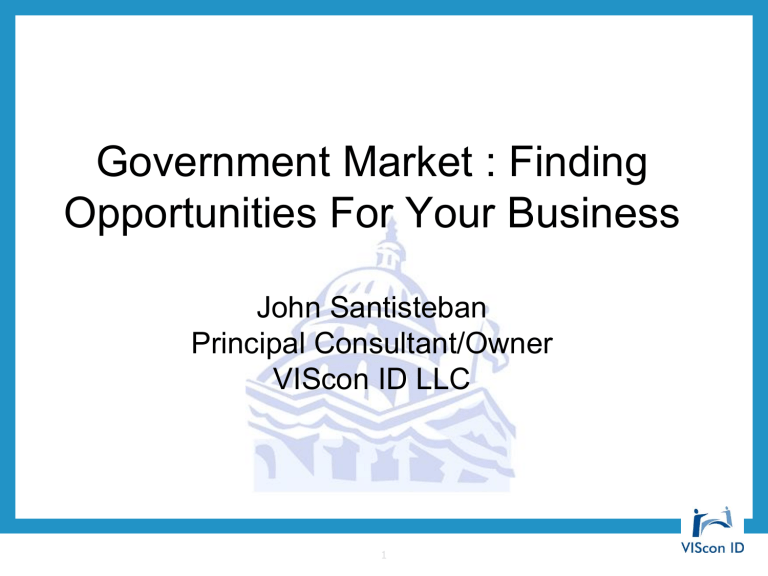
Government Market : Finding
Opportunities For Your Business
John Santisteban
Principal Consultant/Owner
VIScon ID LLC
1
Agenda
Discuss how:
You will be able to find your Target Agencies: the ones who are planning to buy the product / service that you are selling.
You will be able to find your Target Contact: The person(s) who are involved in the requisitioning and purchase of your product / service.
You will know how to succeed at every event you attend.
Federal Market Analysis - Agencies
United States Department of Agriculture(21)
United States Department of Commerce(17)
United States Department of Defense(49)
United States Army(64)
Army Corps of Engineers
United States Navy (60)
Marine Corps (18)
United States Air Force (71)
National Guard Bureau
Air National Guard
Army National Guard
Defense Advanced Research Projects Agency
Defense Logistics Agency
National Security Agency
Pentagon Force Protection Agency
United States Department of Education(10)
United States Department of Energy(5)
United States Department of Health and Human Services(14)
Centers for Disease Control and Prevention
Centers for Medicare and Medicaid Services
Food and Drug Administration
National Institutes of Health
3
Federal Agencies (cont.)
United States Department of Homeland Security (17/64)
Federal Emergency Management Agency
Transportation Security Administration
United States Citizenship and Immigration Services
United States Coast Guard
United States Customs and Border Protection
U.S. Border Patrol
United States Immigration and Customs Enforcement
United States Department of Housing and Urban Development (2)
United States Department of the Interior(10)
United States Department of Justice(53)
Federal Bureau of Investigation
Federal Bureau of Prisons
United States Department of Labor (12)
United States Department of State (55)
United States Department of Transportation (13)
United States Department of the Treasury(11)
Internal Revenue Service
United States Department of Veterans Affairs (3)
Veterans Benefits Administration
Veterans Health Administration
Federal Agencies (cont.)
Independent Agencies and Government Corporations (72 )
Amtrak (National Railroad Passenger Corporation)
Central Intelligence Agency
Environmental Protection Agency
Federal Communications Commission
Federal Reserve System
Federal Trade Commission
General Services Administration
National Aeronautics and Space Administration
National Archives and Records Administration
National Science Foundation
Nuclear Regulatory Commission
Peace Corps
Securities and Exchange Commission
Social Security Administration
Tennessee Valley Authority
United States Postal Service
Federal Market Analysis - Facts
The Federal Government is the largest purchaser of goods and services in the world – FY13 $394B in Contract procurements
Nearly 50% of procurements happen outside the Beltway
Federal Government Employees = 3.1 Million
Number of Buildings Owned = 420,000
Number of Buildings Leased = 77,000
How different is it to sell to Federal Market?
It is essentially the same as the commercial market.
You have to find out who buys what you sell
Knock on their door
Prepare for rejection if unknown to federal buyers
Find a way to get around their resistance to newcomers
In the federal market, as in the commercial market, businesses must sell to the end users of the product or service they offer.
The difference with the federal market is that it is critical that you have a way to close the sale ( e.g. GSA Schedule)
Responding to bids and request for proposals in which you were not involved is NOT selling
Who can buy from a GSA Schedule?
What are Eligible Organizations to Use GSA Sources of Supplies and Services? Go to www.gsa.gov/portal/content/104212 .
List includes:
Executive Agencies (94) e.g. USDA, DOD, Dept. of Commerce, Dept. of State, Dept of
Energy
Other Eligible Users (66) e.g. Red Cross, Federal Courts, DC Government, Army/AF
Exchange
International Organizations and Others Determined Eligible under
Section 607 of the Foreign Assistance Act e.g. United Nations, WHO, NATO, OAS, Int. Monetary Fund
The Cooperative Purchasing Program gives state and local government entities access to purchase information technology products and services (Sch 70) and law enforcement/security products and services (Sch 84)
What Organizations Buy What I Sell?
First Step – Classify what you sell
1. The North American Industry Classification System (NAICS) is the standard used by Federal statistical agencies in classifying business establishments. (NAICS replaced SIC System in 1997)
Go to http://www.census.gov/eos/www/naics/
NOTE: Your product or services could be listed under a number of
NAICS codes. MORE IS BETTER as long as they are relevant.
2. Product Service Codes (PSC) and Federal Supply Codes (FSC) are used by the Federal government to describe the products, services, and research and development purchased by the government. Government procurement specialists and government contractors alike require a solid understanding of these codes in order to produce quality partnerships between buyers and suppliers.
Go to http://www.outreachsystems.com/resources/tables/pscs/
What Organizations Buy What I Sell? Cont.
Market research is a powerful tool used in finding out who is buying, and what, when and why they are buying.
A.
Use Federal Procurement Data Systems – Next Generation (FPDS-NG) – to identify who bought what, from whom, for how much, when and where.
Find it at https://www.fpds.gov/fpdsng_cms/ .You need to register to use system (you need Internet Explorer to use all features). Use your
NAICS or PCS code
What Organizations Buy What I Sell? Cont.
B. Explore www.usaspending.gov
after using FPDS-NG to find contracts and awards, use this site to get a more detailed copy of the contract by searching on the Award ID# or related information
C. Register on www.fedbizopps.gov
. Virtual marketplace for federal procurement opportunities that exceed $25,000. By signing up for this free service, you automatically receive procurement information.
D. Research the Defense Logistics Agency (DLA) procurements at www.dla.mil
and DIBBS at https://www.dibbs.bsm.dla.mil/ .
E. Utilize the Department of Defense (DoD) Procurement Technical Assistance
Centers (PTACs) as a local resource. www.aptac-us.org
.
F. Always consider military installations as potential sales opportunities. For more information, visit www.defenselink.mil/faq/pis/sites.html
.
G. GSA’s Office of Small Business Utilization may be able to provide more assistance. Mission is to promote increased access for small businesses to GSA’s nationwide procurement opportunities. w ww.gsa.gov/aboutosbu .
Closing a Sale – How Does Your Target Buy?
A number of factors including purchase amount and government purchasing rules may affect how a Target Agency transacts a purchase. It is important that you understand the process BEFORE you begin your POC search. Contact the Agency HQ Contracting Office for assistance.
Typical process: The federal end user meets with vendors and obtain information on the F & B’s and past performance of a company's product or service. The end user then meets with the contracting officer, who will ask how much money is involved. This is where the process becomes complex.
The following are methods a federal purchase can be closed or transacted:
A credit card buy (the quickest and simplest)
Purchaser order for amounts under $25,000; three quotes (relatively simple)
A public bid (long, lengthy, expensive, and to be avoided if possible)
A multi-vendor contract that allows the government to purchase from a select list of vendors who are pre-qualified (GSA Schedule, GWAC, other)
A subcontract with a prime contractor that already has a federal contract
A subcontract with a “preferred” SB can contract with quickly and with limited competition (e.g., a small disadvantaged business, 8a, SDVOSB)
Who Needs What I Sell?
Products, services, and solutions are sold through relationships in both the commercial and federal sectors. In the federal arena, relationships are critical because most federal customers are extremely risk averse.
A consultative sales approach is critical to your success. First, federal buyers rely on contractors more than their counterparts in the commercial sector. A federal buyer's entire career (promotions, salary, future opportunities) can depend on a contractor’s performance.
You need to find the buyer's comfort zone and eliminate risk as much as possible. Avoiding or minimizing risk is the primary reason that federal buyers favor incumbent contractors and large prime contractors.
A. Explore www.usa.gov
, as it is the U.S. government official web portal with direct links to government agencies, news and features.
Who Needs What I Sell? Cont.
B. Each federal agency is required to designate Small Business
Specialists who act as small business advocates and interface on behalf of small businesses with government contracting officers (COs), contract specialists, and agency Endusers. Typically,
Small Business Specialists are a part of each agency’s small business office (or Office of Small and Disadvantaged Business
Utilization)
C. When searching FPDS or FedBizOpps the contracting office is identified as well as a award ID. Call the Contracting office and a
Contracting officers will usually tell you who won a contract when an award document cannot be found to match the Solicitation.
D. Use the Internet and phone calls to conduct research on the targeted agency’s programs, the structure of the organization, and each individual’s job responsibilities. Talk to other vendors and use your networking contacts.
E. Contact Teaming partner and Prime Contractor Business
Development professionals and work with them to get you introduced to qualified endusers
Working Events for Prospects
1. Promote your business at professional or trade events:
Government, Technology, Industry, Profession, Other
2. National vs Regional Events
Start at local and regional events - lower cost-booth fee and travel cost is less, leads closer to home
3. Promote yourself for Free – Request speaking opportunity or respond to Call for Speakers. You need a unique and timely presentation topic.
4. Ask your customers or prospects what conferences or tradeshows they attend. Note- cost cuts have reduced out of state participation at national events
5. Work with a complementary teaming partner to share a booth or with a supplier or prime to work in their booth
Working Events for Prospects
6. Goal - lead generation, visibility, promotion, market education, immediate sales
7. Think before you invest - research event - who attends, average attendance, format for exhibits (how often and how long do conference attendees have to visit exhibit area, are attendees rewarded for making the rounds- good and bad.
8. Go to website for search of associations and tradeshows https://data.govloop.com/Government/List-of-Government-
Employee-Associations/hek6-gsm6
9. Many tradeshows linked to associations. Join or become a corporate sponsor for public professional association
10. DC focus of government related conferences and tradeshows
Thank you
John Santisteban
VIScon ID LLC
1916 Aquinas Drive
Gambrills, MD 21054
Johns@viscon-id.com
(c) 202-997-7241
(0) 410-721-1344

